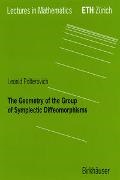Condividi
Fr. 104.00
Leonid Polterovich
The Geometry of the Group of Symplectic Diffeomorphism
Inglese · Tascabile
Spedizione di solito entro 6 a 7 settimane
Descrizione
The group of Hamiltonian diffeomorphisms Ham(M, 0) of a symplectic mani fold (M, 0) plays a fundamental role both in geometry and classical mechanics. For a geometer, at least under some assumptions on the manifold M, this is just the connected component of the identity in the group of all symplectic diffeomorphisms. From the viewpoint of mechanics, Ham(M,O) is the group of all admissible motions. What is the minimal amount of energy required in order to generate a given Hamiltonian diffeomorphism I? An attempt to formalize and answer this natural question has led H. Hofer [HI] (1990) to a remarkable discovery. It turns out that the solution of this variational problem can be interpreted as a geometric quantity, namely as the distance between I and the identity transformation. Moreover this distance is associated to a canonical biinvariant metric on Ham(M, 0). Since Hofer's work this new ge ometry has been intensively studied in the framework of modern symplectic topology. In the present book I will describe some of these developments. Hofer's geometry enables us to study various notions and problems which come from the familiar finite dimensional geometry in the context of the group of Hamiltonian diffeomorphisms. They turn out to be very different from the usual circle of problems considered in symplectic topology and thus extend significantly our vision of the symplectic world.
Sommario
Preface.- 1 Introducing the Group.- 1.1 The origins of Hamiltonian diffeomorphisms.- 1.2 Flows and paths of diffeomorphisms.- 1.3 Classical mechanics.- 1.4 The group of Hamiltonian diffeomorphisms.- 1.5 Algebraic properties of Ham(M, Q).- 2 Introducing the Geometry.- 2.1 A variational problem.- 2.2 Biinvariant geometries on Ham(M, Q).- 2.3 The choice of the norm: Lp vs. Loa.- 2.4 The concept of displacement energy.- 3 Lagrangian Submanifolds.- 3.1 Definitions and examples.- 3.2 The Liouville class.- 3.3 Estimating the displacement energy.- 4 The $$bar partial$$-Equation.- 4.1 Introducing the $$bar partial$$-operator.- 4.2 The boundary value problem.- 4.3 An application to the Liouville class.- 4.4 An example.- 5 Linearization.- 5.1 The space of periodic Hamiltonians.- 5.2 Regularization.- 5.3 Paths in a given homotopy class.- 6 Lagrangian Intersections.- 6.1 Exact Lagrangian isotopies.- 6.2 Lagrangian intersections.- 6.3 An application to Hamiltonian loops.- 7 Diameter.- 7.1 The starting estimate.- 7.2 The fundamental group.- 7.3 The length spectrum.- 7.4 Refining the estimate.- 8 Growth and Dynamics.- 8.1 Invariant tori of classical mechanics.- 8.2 Growth of one-parameter subgroups.- 8.3 Curve shortening in Hofer's geometry.- 8.4 What happens when the asymptotic growth vanishes?.- 9 Length Spectrum.- 9.1 The positive and negative parts of Hofer's norm.- 9.2 Symplectic fibrations over S2.- 9.3 Symplectic connections.- 9.4 An application to length spectrum.- 10 Deformations of Symplectic Forms.- 10.1 The deformation problem.- 10.2 The $$bar partial$$-equation revisited.- 10.3 An application to coupling.- 10.4 Pseudo-holomorphic curves.- 10.5 Persistence of exceptional spheres.- 11 Ergodic Theory.- 11.1 Hamiltonian loops as dynamical objects.- 11.2 Theasymptotic length spectrum.- 11.3 Geometry via algebra.- 12 Geodesics.- 12.1 What are geodesics?.- 12.2 Description of geodesics.- 12.3 Stability and conjugate points.- 12.4 The second variation formula.- 12.5 Analysis of the second variation formula.- 12.6 Length minimizing geodesics.- 13 Floer Homology.- 13.1 Near the entrance.- 13.2 Morse homology in finite dimensions.- 13.3 Floer homology.- 13.4 An application to geodesics.- 13.5 Towards the exit.- 14 Non-Hamiltonian Diffeomorphisms.- 14.1 The flux homomorphism.- 14.2 The flux conjecture.- 14.3 Links to "hard" symplectic topology.- 14.4 Isometries in Hofer's geometry.- List of Symbols.
Riassunto
The group of Hamiltonian diffeomorphisms Ham(M, 0) of a symplectic mani fold (M, 0) plays a fundamental role both in geometry and classical mechanics. For a geometer, at least under some assumptions on the manifold M, this is just the connected component of the identity in the group of all symplectic diffeomorphisms. From the viewpoint of mechanics, Ham(M,O) is the group of all admissible motions. What is the minimal amount of energy required in order to generate a given Hamiltonian diffeomorphism I? An attempt to formalize and answer this natural question has led H. Hofer [HI] (1990) to a remarkable discovery. It turns out that the solution of this variational problem can be interpreted as a geometric quantity, namely as the distance between I and the identity transformation. Moreover this distance is associated to a canonical biinvariant metric on Ham(M, 0). Since Hofer's work this new ge ometry has been intensively studied in the framework of modern symplectic topology. In the present book I will describe some of these developments. Hofer's geometry enables us to study various notions and problems which come from the familiar finite dimensional geometry in the context of the group of Hamiltonian diffeomorphisms. They turn out to be very different from the usual circle of problems considered in symplectic topology and thus extend significantly our vision of the symplectic world.
Dettagli sul prodotto
| Autori | Leonid Polterovich |
| Editore | Springer, Basel |
| Lingue | Inglese |
| Formato | Tascabile |
| Pubblicazione | 01.03.2001 |
| EAN | 9783764364328 |
| ISBN | 978-3-7643-6432-8 |
| Pagine | 136 |
| Dimensioni | 169 mm x 246 mm x 5 mm |
| Peso | 282 g |
| Illustrazioni | XII, 136 p. 2 illus. |
| Serie |
Lectures in Mathematics Lectures in Mathematics. ETH Zürich |
| Categorie |
Scienze naturali, medicina, informatica, tecnica
> Matematica
> Geometria
Geometrie, C, geometry, Mathematics and Statistics, Manifold, Differential Geometry, symplectic manifold, global analysis |
Recensioni dei clienti
Per questo articolo non c'è ancora nessuna recensione. Scrivi la prima recensione e aiuta gli altri utenti a scegliere.
Scrivi una recensione
Top o flop? Scrivi la tua recensione.

